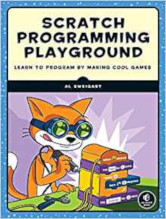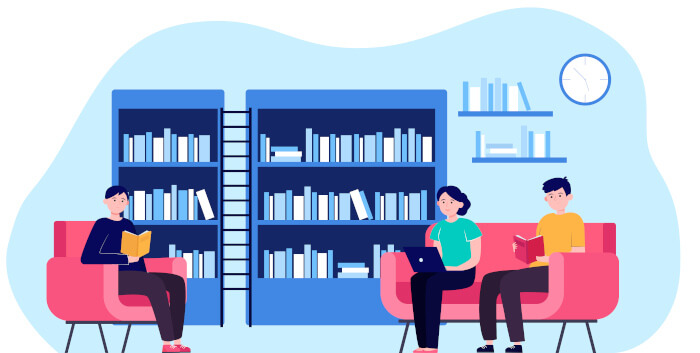Last Updated on June 3, 2025
Scratch is a visual programming language developed by the Lifelong Kindergarten Group at the MIT Media Lab. Scratch teaches programming concepts to kids, offering a stepping stone to more complicated programming languages. Coding includes dragging and dropping various code blocks and linking them together like jigsaw pieces to form logical scripts. While the MIT Media Lab designed this language for 8-16 year-old children, it is used by people of all ages.
Scratch has received many plaudits as an ideal way to introduce kids to computer programming and computational thinking. It’s a fantastic beginner’s language. Scratch is often used to make games, interactive stories, and animations, but it can be used for any purpose. The language uses event-driven programming with multiple active objects. The language helps students to think creatively, reason logically, and work together. The language is frequently used in schools, libraries, community centres, and museums.
Scratch is released under an open source license. I recommend 7 free books that really help young people master Scratch. These recommended texts are also open source goodness.
1. Scratch Programming Playground: Learn to Program by Making Cool Games by Al Sweigart
 Scratch Programming Playground: Learn to Program warrants our strongest recommendation for anyone looking to learn Scratch from scratch (pun intended). You don’t need any programming knowledge. As long as you’ve mastered basic arithmetic, you’ll be fine with the material here. The book makes Scratch very easy to learn for all ages.
Scratch Programming Playground: Learn to Program warrants our strongest recommendation for anyone looking to learn Scratch from scratch (pun intended). You don’t need any programming knowledge. As long as you’ve mastered basic arithmetic, you’ll be fine with the material here. The book makes Scratch very easy to learn for all ages.
This book is not intended to offer a complete guide to Scratch, but there’s enough material to begin you on your journey. Along the way you’ll learn Scratch by writing some fun games such as Maze Runner, Fruit Slicer, Platformer, and Asteroid Breaker.
Scratch Programming Playground is free to read online under a Creative Commons license.
The online version is available to read at https://inventwithscratch.com/book/. There’s also print and ebook versions available to purchase.
2. Learn to Code with Scratch by The MagPi Team
 Learn to Code with Scratch helps you start coding with Scratch, guiding you step by step through the process of creating all sorts of projects: games, animations, quizzes, electronics circuits, and more.
Learn to Code with Scratch helps you start coding with Scratch, guiding you step by step through the process of creating all sorts of projects: games, animations, quizzes, electronics circuits, and more.
It’s educational and bags of fun.
The book is licensed under a Creative Commons license.
Read the PDF book at https://www.raspberrypi.org/magpi-issues/Essentials_Scratch_v1.pdf.
3. {code club} Book of Scratch by Rik Cross, Tracy Gardner
 Book of Scratch teaches you how to code with Scratch and Code Club.
Book of Scratch teaches you how to code with Scratch and Code Club.
You’ll tackle fun topics such as how to use Scratch and start coding, make music with a fun coding project, create an animation, build a spooky ghost-catching game, code your own chatbot, learn how co-ordinates work with a fun game, create a boat racing game, and there’s some handy cope snippets for integrating in your own projects.
If you’re not aware, Code Club is a fantastic collection of computing clubs around the world where young people learn how to write games, animations, websites, and more.
Read this PDF book here. The book is licensed under Creative Commons Attribution-NonCommercial-ShareAlike 3.0 Unported (CC BY-NC-SA 3.0)
The MagPi Team have written other useful computing books away from Scratch such as an Introduction to C & GUI programming.
4. An Introduction to Computing Science: Starting from Scratch – (updated 2016 using Scratch 2)
 This book seeks to introduce learners to Computing Science via the Scratch 2.0 programming environment.
This book seeks to introduce learners to Computing Science via the Scratch 2.0 programming environment.
The package includes a tutor pack, a learner pack, together with media files, and screencasts.
Chapters cover the following topics: Scratching the Surface, Story Time, A Mazing Game, Get the Picture?, and Forest Archery Game.
Some of the material within this resource is based on existing work from the ScratchEd site, reproduced and adapted under Creative Commons license.
To read the book visit the Computer Science Resources section at https://www.rse.org.uk/schools/resources/.
Next page: Page 2 – Creative Computing and more books
Pages in this article:
Page 1 – Scratch Programming Playground: Learn to Program by Making Cool Games and more books
Page 2 – Creative Computing and more books
All books in this series:
| Free Programming Books | |
|---|---|
| Ada | ALGOL-like programming language, extended from Pascal and other languages |
| Agda | Dependently typed functional language based on intuitionistic Type Theory |
| Arduino | Inexpensive, flexible, open source microcontroller platform |
| Assembly | As close to writing machine code without writing in pure hexadecimal |
| Awk | Versatile language designed for pattern scanning and processing language |
| Bash | Shell and command language; popular both as a shell and a scripting language |
| BASIC | Beginner’s All-purpose Symbolic Instruction Code |
| C | General-purpose, procedural, portable, high-level language |
| C++ | General-purpose, portable, free-form, multi-paradigm language |
| C# | Combines the power and flexibility of C++ with the simplicity of Visual Basic |
| Clojure | Dialect of the Lisp programming language |
| ClojureScript | Compiler for Clojure that targets JavaScript |
| COBOL | Common Business-Oriented Language |
| CoffeeScript | Transcompiles into JavaScript inspired by Ruby, Python and Haskell |
| Coq | Dependently typed language similar to Agda, Idris, F* and others |
| Crystal | General-purpose, concurrent, multi-paradigm, object-oriented language |
| CSS | CSS (Cascading Style Sheets) specifies a web page’s appearance |
| D | General-purpose systems programming language with a C-like syntax |
| Dart | Client-optimized language for fast apps on multiple platforms |
| Dylan | Multi-paradigm language supporting functional and object-oriented coding |
| ECMAScript | Best known as the language embedded in web browsers |
| Eiffel | Object-oriented language designed by Bertrand Meyer |
| Elixir | Relatively new functional language running on the Erlang virtual machine |
| Erlang | General-purpose, concurrent, declarative, functional language |
| F# | Uses functional, imperative, and object-oriented programming methods |
| Factor | Dynamic stack-based programming language |
| Forth | Imperative stack-based programming language |
| Fortran | The first high-level language, using the first compiler |
| Go | Compiled, statically typed programming language |
| Groovy | Powerful, optionally typed and dynamic language |
| Haskell | Standardized, general-purpose, polymorphically, statically typed language |
| HTML | HyperText Markup Language |
| Icon | Wide variety of features for processing and presenting symbolic data |
| J | Array programming language based primarily on APL |
| Java | General-purpose, concurrent, class-based, object-oriented, high-level language |
| JavaScript | Interpreted, prototype-based, scripting language |
| Julia | High-level, high-performance language for technical computing |
| Kotlin | More modern version of Java |
| LabVIEW | Designed to enable domain experts to build power systems quickly |
| LaTeX | Professional document preparation system and document markup language |
| Lisp | Unique features - excellent to study programming constructs |
| Logo | Dialect of Lisp that features interactivity, modularity, extensibility |
| Lua | Designed as an embeddable scripting language |
| Markdown | Plain text formatting syntax designed to be easy-to-read and easy-to-write |
| Objective-C | Object-oriented language that adds Smalltalk-style messaging to C |
| OCaml | The main implementation of the Caml language |
| Pascal | Imperative and procedural language designed in the late 1960s |
| Perl | High-level, general-purpose, interpreted, scripting, dynamic language |
| PHP | PHP has been at the helm of the web for many years |
| PostScript | Interpreted, stack-based and Turing complete language |
| Prolog | A general purpose, declarative, logic programming language |
| PureScript | Small strongly, statically typed language compiling to JavaScript |
| Python | General-purpose, structured, powerful language |
| QML | Hierarchical declarative language for user interface layout - JSON-like syntax |
| R | De facto standard among statisticians and data analysts |
| Racket | General-purpose, object-oriented, multi-paradigm, functional language |
| Raku | Member of the Perl family of programming languages |
| Ruby | General purpose, scripting, structured, flexible, fully object-oriented language |
| Rust | Ideal for systems, embedded, and other performance critical code |
| Scala | Modern, object-functional, multi-paradigm, Java-based language |
| Scheme | A general-purpose, functional language descended from Lisp and Algol |
| Scratch | Visual programming language designed for 8-16 year-old children |
| SQL | Access and manipulate data held in a relational database management system |
| Standard ML | General-purpose functional language characterized as "Lisp with types" |
| Swift | Powerful and intuitive general-purpose programming language |
| Tcl | Dynamic language based on concepts of Lisp, C, and Unix shells |
| TeX | Markup and programming language - create professional quality typeset text |
| TypeScript | Strict syntactical superset of JavaScript adding optional static typing |
| Vala | Object-oriented language, syntactically similar to C# |
| VHDL | Hardware description language used in electronic design automation |
| VimL | Powerful scripting language of the Vim editor |
| XML | Rules for defining semantic tags describing structure ad meaning |

Interesting and creative! for children. Thanks for sharing.